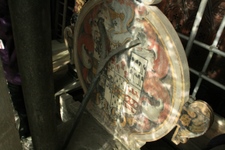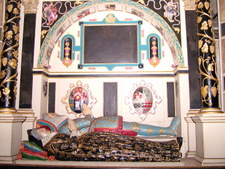Conservator’s amazing new find on 17th century tomb
Salisbury Cathedral conservator Dave Henson made a great discovery when he started the latest round of practical conservation work on the Monument to Sir Richard Mompesson (d.1627) and his wife Katherine. He found what is believed to be a 17th century polychromed Coat of Arms on the reverse of the stone supporting the Coat of Arms at the top and front of the monument. And the blazoning of the two Coats of Arms is almost identical.
Peter Martindale, polychrome expert, says “The Coat of Arms on the reverse of the monument is important historically and artistically, and quite rare. It appears not to have undergone a programme of treatment since being painted, its condition seems good, and it is therefore a valuable witness to the methods and materials of the time.”
One possibility is that it could be a ‘draft’ painting of the Coat of Arms found on the front of the armorial. It covers the entire back of the top section of the tomb, but is the only painting on the back of the tomb.

The Mompesson Tomb is an elaborate large wall table/ tomb chest of painted and gilded Chilmark stone, with recumbent effigies, and built after 1627. It has been repainted twice since the early 17th century original painting, the first repaint possibly late 17th/early 18th century and the second in 1964. It was originally located on the north side of the quire in the north nave aisle, perhaps in a position where both sides of the monument could be seen. It was moved to the south wall of the south side aisle in 1877 when the Father Willis organ was installed.









